
by Helga Moser | Nov, 2025 | Bonn Sights, culinary, EN, points of interest, Rhine region, tradition
When the days get darker in the dreary month of November and the wet cold dampens the mood, I go to the Christmas market before the winter blues gets a hold of me. Around the Münsterplatz in Bonn, wooden stalls are set up and create a cosy atmosphere with Christmas decorations and bright lights. The enticing aromas of mulled wine, cinnamon, roasted almonds and delicious food inevitably lift the spirits.
At the foot of the Bonn Minster, the city is teeming with life, but at the same time it feels homely . I feel transported back in time and imagine how our Bonn ancestors came to this square in the late Middle Ages to stock up on supplies for the coming winter, to enjoy good food and drink and, of course, to exchange the latest gossip.
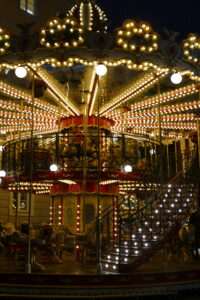
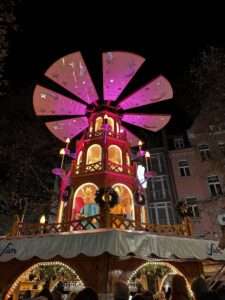 Today, more than half a millennium later, it is not much different. In a large part of the 160 wooden stalls placed between Remigiusplatz, Münsterplatz and Friedensplatz, you can buy beautiful and useful items, including hand-made crafts, which make for great Christmas presents for family and friends. Here you will find unique items that are not available in the usual department stores. Inspired by the lovingly decorated displays, you’ll discover gifts that you would never have thought of while lounging on your sofa at home. For example, original jewellery pendants or maybe hand-knitted socks made of pure wool for your daughter, who always has cold feet? And for your girlfriend, who already has everything, a new Christmas ornament is always a hit! And of course, every once in a while I need a little refreshment. The Flammlachs (salmon cooked on an open fire) smells seductive, but I usually return to the Rhine-region classic, Reibekuchen, potatoe pancakes with apple compote. In addition, the sounds of Christmas can be heard from everywhere. The happy laughter of children coming from the direction of the historic carousel reminds me of the dear little ones in my family. For them, I have to make a choice between a handcrafted wooden toy and a cute Perlgraupentier (a figurine of a German miner). Slowly, the shopping bag I brought with me is proving not big enough. But I don’t need to worry because one of the traditional stalls has a selection of beautiful baskets: I have been eyeing them for a long time. No sooner said than done – now I just have to get the hand-made wrapping paper and my Christmas market tour will be a roaring success.
Today, more than half a millennium later, it is not much different. In a large part of the 160 wooden stalls placed between Remigiusplatz, Münsterplatz and Friedensplatz, you can buy beautiful and useful items, including hand-made crafts, which make for great Christmas presents for family and friends. Here you will find unique items that are not available in the usual department stores. Inspired by the lovingly decorated displays, you’ll discover gifts that you would never have thought of while lounging on your sofa at home. For example, original jewellery pendants or maybe hand-knitted socks made of pure wool for your daughter, who always has cold feet? And for your girlfriend, who already has everything, a new Christmas ornament is always a hit! And of course, every once in a while I need a little refreshment. The Flammlachs (salmon cooked on an open fire) smells seductive, but I usually return to the Rhine-region classic, Reibekuchen, potatoe pancakes with apple compote. In addition, the sounds of Christmas can be heard from everywhere. The happy laughter of children coming from the direction of the historic carousel reminds me of the dear little ones in my family. For them, I have to make a choice between a handcrafted wooden toy and a cute Perlgraupentier (a figurine of a German miner). Slowly, the shopping bag I brought with me is proving not big enough. But I don’t need to worry because one of the traditional stalls has a selection of beautiful baskets: I have been eyeing them for a long time. No sooner said than done – now I just have to get the hand-made wrapping paper and my Christmas market tour will be a roaring success.
A toast is in order! Relaxing as Christmas approaches, I treat myself to an eggnog, a drink made from white wine, egg liqueur, vanilla and sugar, served hot and garnished with whipped cream. It actually sounds rather fearsome, but it is surprisingly delicious and hits the spot. The fact that I’m standing here alone doesn’t bother me at all. Because we are in the Rhineland it takes no time at all before I am chatting with a fellow eggnog-drinker about the Christmas season.
Of course, this will not be my only visit to a Christmas market. Like so many, I will meet up with friends for a mulled wine on numerous occasions throughout the season. It sweetens up the dreary weather – and when it’s bitter cold outside, the drinks taste even better!
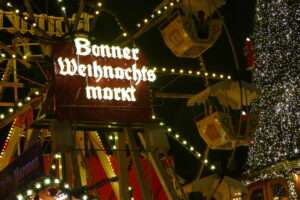 And soon, I’ll be going to the Bonn Greeters’ Christmas market meet-up, which takes place every year. We’ll be swapping anecdotes and information, taking a stroll through the rows of stalls and sampling the wares at various stands. Of course, it’s all preparation for when we show guests around the market, as Christmas markets are one of the top points of interest.
And soon, I’ll be going to the Bonn Greeters’ Christmas market meet-up, which takes place every year. We’ll be swapping anecdotes and information, taking a stroll through the rows of stalls and sampling the wares at various stands. Of course, it’s all preparation for when we show guests around the market, as Christmas markets are one of the top points of interest.
The Christmas market is open until 23 December, with stalls open from 11 a.m. to 9 p.m., and food and drink stalls open until 9:30 p.m. on Sundays to Thursdays, and until 10:30 p.m. on Fridays and Saturdays. And for those who don’t want to leave the cosy setting so quickly, Bonn Tourism there is a Holy Three Kings’ market, which will extend beyond the pre-Christmas period. It will take place on Remigiusplatz from 27 December up to and including 6 January.

by Gert Fischer | Oct, 2025 | Bonn Sights, famous people from Bonn, history, points of interest
In 2025, the Fördergesellschaft für den Alten Friedhof Bonn e.V. (Friends of Bonn’s Old Cemetery Association) celebrates its 50th anniversary. The Bonn Greeters would like to offer their heartfelt congratulations! Through its work, the association makes an important contribution to the preservation and maintenance of one of Bonn’s most significant historical landmarks.
 The so-called ‘Old Cemetery’ is easy to overlook. It is surrounded by walls and squeezed between three main roads and the railway line. Its entrance is at the beginning of Bornheimer Straße, almost directly next to the town hall. When you walk through the gate you enter another world. Graves from times long past lie in the shade of tall trees. Weathered gravestones and rusted wrought-iron crosses dominate the scene. Some are crooked. Many of the graves are obviously no longer maintained and are overgrown. The traffic noise fades into the background and birdsong dominates. It is no wonder that feature films are occasionally shot here. Fog machines are turned on and eerie figures stride through the night. The rattling of the railway is suppressed.
The so-called ‘Old Cemetery’ is easy to overlook. It is surrounded by walls and squeezed between three main roads and the railway line. Its entrance is at the beginning of Bornheimer Straße, almost directly next to the town hall. When you walk through the gate you enter another world. Graves from times long past lie in the shade of tall trees. Weathered gravestones and rusted wrought-iron crosses dominate the scene. Some are crooked. Many of the graves are obviously no longer maintained and are overgrown. The traffic noise fades into the background and birdsong dominates. It is no wonder that feature films are occasionally shot here. Fog machines are turned on and eerie figures stride through the night. The rattling of the railway is suppressed.
The cemetery has been in existence since 1715. At that time, it was located just outside the city fortifications. It owes its triangular layout to the fork in the road where Archbishop Elector Joseph Clemens – better known as the creator of the residential palace, now the university – had it laid out. It was originally intended for soldiers, strangers and poor people, i.e. those whose families did not have graves in the inner-city cemeteries. In 1787, it became the city’s only cemetery: Elector Max Franz closed the parish cemeteries and turned it into a ‘general burial ground’. The reason for this was the realisation that the overcrowded churchyards posed a health risk to the city’s population. In this respect, Bonn was ahead of its time. In most other cities in the Rhineland, such measures were only ordered during French rule after 1794.
The Old Cemetery retained its function as ‘the’ Bonn cemetery until its closure in 1884. From then on, burials were only permitted if the family already had a grave on the site, as there was no more room for expansion. The cemetery was surrounded by buildings on all sides.
An information board at the entrance, as well as the Fördergesellschaft’s website, offer maps and a detailed overview of the VIP tombstones . There is much more to discover than the graves of Beethoven’s mother, Clara and Robert Schumann, Barthold Georg Niebuhr or Ernst Moritz Arndt, because the Old Cemetery reflects the history of bourgeois Bonn in the 19th century. In addition to the graves of well-known and lesser-known Bonn families, the resting places of university professors also play an important role. This part of the cemetery register reads like a “Who’s Who” of the German scholarly world of that time. Scattered across the grounds, we also find traces of the British colony, which was important for the social history of the city. Somewhat hidden away are the graves of French soldiers from the war of 1870/71. Added to this is the art-historical dimension. A tour of the cemetery is always a journey through the representative funeral culture of the 19th century. Particularly important are the cemetery chapel – built in the 13th century as the chapel of the Teutonic Order in Ramersdorf and moved here in the 1840s as an early example of monument preservation – and the former market cross of the medieval market in Dietkirchen in the north of Bonn.
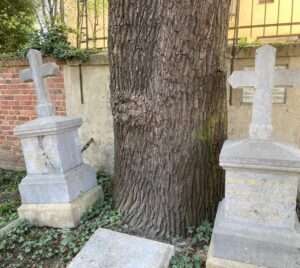 Another treasure of the Old Cemetery is its trees, some of which date back to the 19th century. This is where problems become apparent: in some places, monument preservation and nature conservation compete with each other, as the tree roots threaten historic graves. Nowhere is this more evident than at the grave of Ernst Moritz Arndt, where the oak tree he planted himself almost 200 years ago is in the process of overturning the gravestones.
Another treasure of the Old Cemetery is its trees, some of which date back to the 19th century. This is where problems become apparent: in some places, monument preservation and nature conservation compete with each other, as the tree roots threaten historic graves. Nowhere is this more evident than at the grave of Ernst Moritz Arndt, where the oak tree he planted himself almost 200 years ago is in the process of overturning the gravestones.
Another problem is that the majority of the graves are no longer in use. The families have died out or now bury their members elsewhere. This means that time has practically stood still. This is a major challenge for the city, because although it can preserve the site as a whole, it does not have the resources to maintain the countless unused graves, let alone preserve the gravestones, apart from the graves of honour. On the other hand, ‘clearing’ the graves after the burial periods have expired, as is customary in normal cemeteries, is not an option due to the historical significance of the site and the existing monument protection. The support association helps to solve this dilemma. Among other things, it is responsible for the restoration of graves of historical or art-historical significance.
Another option is the ‘grave sponsorships’ arranged by the support association. In this case, the sponsors take over the maintenance of an abandoned grave, including the restoration of the gravestone, and thus acquire the right from the city of Bonn to be buried in this grave sometime in the future. Not everyone may like the idea of lying under someone else’s gravestone and being limited to a modest stone cushion with their own name on it. And some people also consider it morbid for someone to maintain their own grave during their lifetime. However, my wife and I find it somehow reassuring to know where we will end up – if nothing else comes in between.
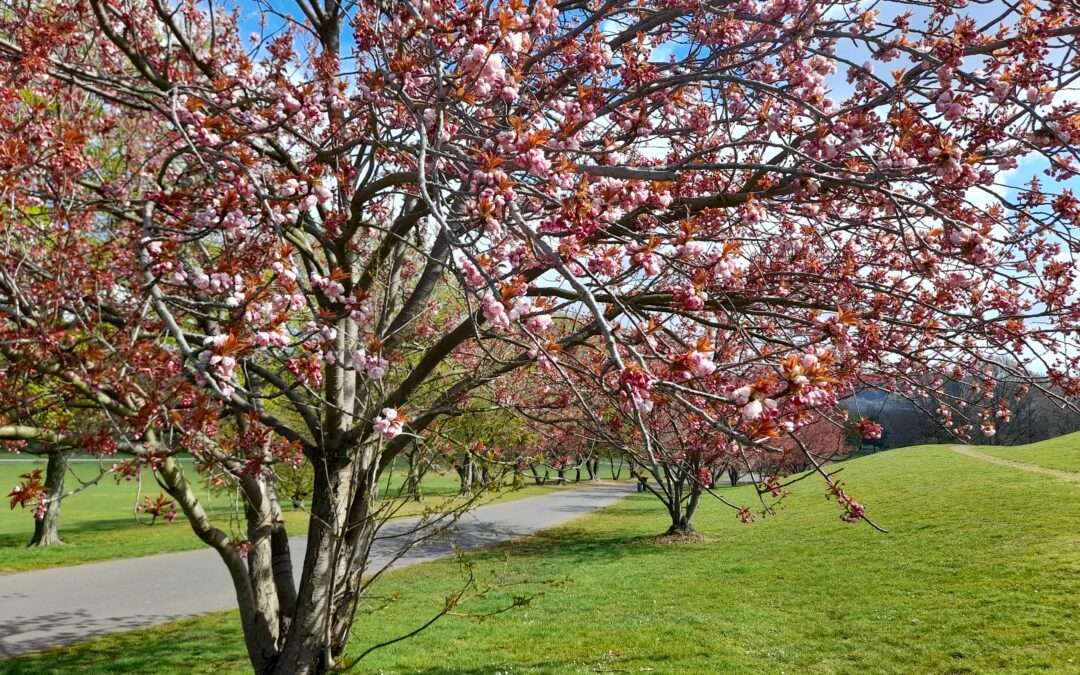
by Helga Stark | Apr, 2025 | Bonn Sights, EN, points of interest, tradition
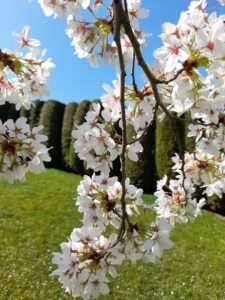 In the first phase the white-flowered cherries, such as the plum cherry in Wolfstraße, Franzstraße or in the Rheinaue, bloom. After that it takes about 14 days for the thick pink-flowered Japanese flowering cherries (especially in Breite Straße and Heerstraße) to delight the eye.
In the first phase the white-flowered cherries, such as the plum cherry in Wolfstraße, Franzstraße or in the Rheinaue, bloom. After that it takes about 14 days for the thick pink-flowered Japanese flowering cherries (especially in Breite Straße and Heerstraße) to delight the eye.
How did Bonn get these magnificent cherries in the first place? In the 1980s, the Old Town (which is actually the Nordstadt and was only renamed ‘Old Town’ for tourist reasons) was redeveloped. Traffic was forced to slow down and Japanese cherries were planned to provide a splash of colour. The cherry trees were a gift from the Japanese government to Bonn and the city planner Brigitte Denkel made sure that they were planted. The cherry blossoms symbolise the friendship between Japan and Germany.
In many cultures, cherry blossoms have a special symbolic meaning, especially in Japan, where they are a symbol of beauty, transience and new beginnings.
On weekends there is also a flea market, design market and food market, which attract tens of thousands of people on the streets. All the shops, cafés and pubs in the area are prepared for the crowds. Those who prefer it quieter come during the week, in the morning or evening. Night photos of the cherry blossoms are also worth the visit after hours.
If you don’t want to plunge into the hustle and bustle, you can find Japanese cherry trees in Beuel, for example, on Professor-Neu-Allee or in the Rheinaue park.
My personal favourite cherry blossom spot is a small avenue in the Rheinaue near the Japanese garden: these cherry trees were donated by a Japanese choir that performs Beethoven’s ‘Ode to Joy’ every year with about 5,000 singers. The cherry trees were a gift in honour of Beethoven’s birthplace. Beethoven is as revered in Japan as the cherry blossom, but that’s another story…
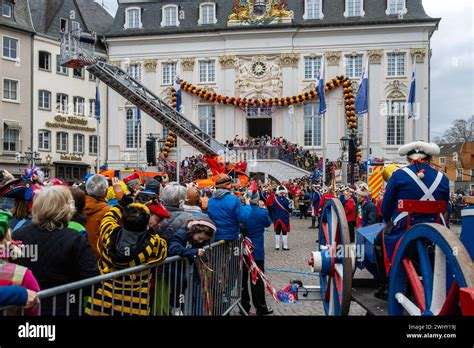
by Susanne Erbay | Feb, 2025 | Bonn Sights, EN, points of interest, tradition
Bonn’s Carnival is also known as the ‘fifth season’ and officially begins on 11 November at 11:11 a.m. and reaches its peak in the days before Ash Wednesday.
Originally Carnival was celebrated as a pagan festival to drive out winter. Later, Carnival was celebrated before the Christian fasting period before Easter. Even though not all Bonn residents like or celebrate Carnival, it has cultural and social significance. Many are involved in carnival clubs, of which there are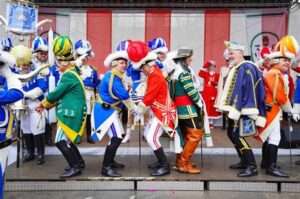 numerous in Bonn and the surrounding districts. Each carnival club has different ‘uniforms’ or costumes. The uniforms date back to the French occupation at the end of the 18th / beginning of the 19th century. The occupiers banned carnival because they feared unrest. But after the occupation ended people celebrated again, wearing the uniforms the French had left behind. This was a way of making fun of the occupiers, and later also of the Prussian occupiers. One remnant is the ‘Stippeföttche’, a dance in which men with sabres and rifles (which shoot flowers!) shimmy their backsides together.
numerous in Bonn and the surrounding districts. Each carnival club has different ‘uniforms’ or costumes. The uniforms date back to the French occupation at the end of the 18th / beginning of the 19th century. The occupiers banned carnival because they feared unrest. But after the occupation ended people celebrated again, wearing the uniforms the French had left behind. This was a way of making fun of the occupiers, and later also of the Prussian occupiers. One remnant is the ‘Stippeföttche’, a dance in which men with sabres and rifles (which shoot flowers!) shimmy their backsides together.
The carnival associations organise many carnival events during the season. There are formal sessions, balls, dance parties, ladies’ sessions, men’s sessions and children’s sessions – there is something for everyone. Many a successful comedian or musician made their first appearances there and laid the foundation for their success.
The street carnival kicks off on Women’s Carnival Day. Traditionally, women storm the town hall on this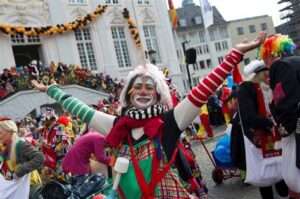 day, cut off the ties of the men and symbolically take power. This custom was introduced over 200 years ago, in 1824, by the Beuel washerwomen. At that time, the men brought the freshly washed laundry to Cologne by ship, received payment for it and promptly squandered it during Carnival. In 1824 the washerwomen had had enough and decided to take drastic action. They got together for a coffee klatch and founded the Old Beuel Women’s Committee 1824 e. V. Since then, the town hall has traditionally been stormed in Beuel where the Women’s Carnival procession also takes place.
day, cut off the ties of the men and symbolically take power. This custom was introduced over 200 years ago, in 1824, by the Beuel washerwomen. At that time, the men brought the freshly washed laundry to Cologne by ship, received payment for it and promptly squandered it during Carnival. In 1824 the washerwomen had had enough and decided to take drastic action. They got together for a coffee klatch and founded the Old Beuel Women’s Committee 1824 e. V. Since then, the town hall has traditionally been stormed in Beuel where the Women’s Carnival procession also takes place.
On Carnival Sunday, the Old Town Hall on Bonn’s market square will be stormed by fools. The mayor will try to defend it – but of course she won’t be able to. From 11 a.m. onwards, there will be a lot of carnival hustle and bustle on Bonn’s market square – come and see for yourself.
The highlight of the Bonn Carnival is the Rose Monday Parade. For several hours decorated floats, groups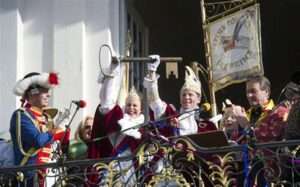 of people on foot and musicians and bands parade through the city centre and the northern part of the city. Thousands of people line the route and collect sweets and bouquets of flowers. For those who have never been: make sure you have enough bags for the sweets.
of people on foot and musicians and bands parade through the city centre and the northern part of the city. Thousands of people line the route and collect sweets and bouquets of flowers. For those who have never been: make sure you have enough bags for the sweets.
The Carnival Prince and the Bonna are the city’s representatives during the carnival season. They take part in numerous events and are the stars of the carnival season, as well as of the Rose Monday parade. The Bonn royal couple’s float is the last one in the Rose Monday parade, before the Bonn-Orange city cleaning service clears away the worst of the dirt from the procession. Everything has to be in order 🙂
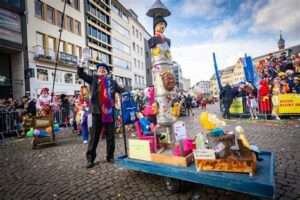 It is definitely worth taking part in the carnival adventure, even if you are not from Bonn.
It is definitely worth taking part in the carnival adventure, even if you are not from Bonn.
More information and dates can be found at here.

by Gert Fischer | Dec, 2024 | Bonn Sights, EN, points of interest, tradition, Uncategorized
The flight of steps at the Old City Hall has seen better days. Its grand appearances have become rare. Nowadays it only takes centre stage on Carnival Sunday, when the carnival revellers storm the town hall. In addition, there are rare events in which it briefly regains its former grandeur as a big stage. This occurred in 2023, when the Telekom Baskets (Bonn’s professional basketball team) were celebrated by their fans after winning the Champions League. Although there was a good turn-out by the fans, they still did not fill the market square, not unlike the party-goers on Carnival Sunday. It was a completely different scenario when Charles de Gaulle signed the city’s Golden Book on the September 5, 1962. He stepped out onto the staircase together with Konrad Adenauer to a storm of enthusiasm. The market square and the Bischofsplatz were packed with people, who were overflowing into the Sternstraße and the Wenzelgasse. After delivering a seemingly extemporaneous speech in German, the then assassination-threatened French President strode down the stairs and was swallowed up by the crowd, much to the dismay of his security staff.
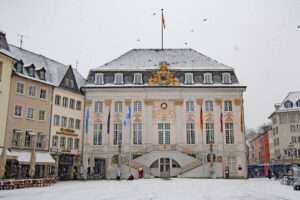
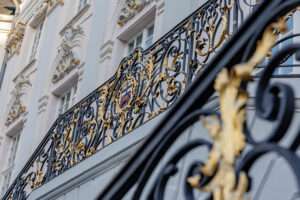
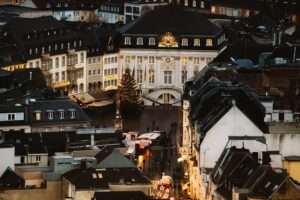
 The steps of Bonn’s old City Hall have seen similar scenes time and again, especially when Bonn was the capital city of Germany. The list of visitors ranged from Theodor Heuss, who addressed the German people from the steps immediately after his election as the first Federal President, to John F. Kennedy in 1963, the Queen Elizabeth of England in 1965, and as late as 1989 when Gorbachev visited. Not all occasions were as spectacular as in the 60s, and over time, state visits became routine. Nevertheless, the steps of the town hall remained something of a stage for the Bonn Republic. The reason for this was mundane: the government district was somewhat remote and, as a provisional arrangement, had no representative assembly area. The market square helped out.
The steps of Bonn’s old City Hall have seen similar scenes time and again, especially when Bonn was the capital city of Germany. The list of visitors ranged from Theodor Heuss, who addressed the German people from the steps immediately after his election as the first Federal President, to John F. Kennedy in 1963, the Queen Elizabeth of England in 1965, and as late as 1989 when Gorbachev visited. Not all occasions were as spectacular as in the 60s, and over time, state visits became routine. Nevertheless, the steps of the town hall remained something of a stage for the Bonn Republic. The reason for this was mundane: the government district was somewhat remote and, as a provisional arrangement, had no representative assembly area. The market square helped out.
Incidentally, the same applies to demonstrations. Up until the 1980s the Bonn market was the most important demonstration site in the Federal Republic of Germany. The steps of the town hall also played a role there – perhaps most ingloriously on 10 April 1973, when members of a communist splinter group, hidden by a student demonstration against the visit of the South Vietnamese president to Germany, stormed the town hall and smashed its interior. It was only then that, because of the sheer volume, the protests against rearmament had to move to the Hofgarten. They may not have been aware of the meaning of their actions in terms of the carnival. At that time, we lived nearby, and I still remember how the demonstrators, linked arms and running, turned from Suttnerplatz into Rathausgasse, chanting the name of Ho Chi Minh. The rest is history.
The staircase was also the scene of much earlier revolutionary events: on 20 March 1848, for example, Gottfried Kinkel led a procession of citizens, professors and students. Armed with the black, red and gold flag of the democratic movement, he climbed the steps of the town hall and spoke, as Carl Schurz put it, with ‘wondrous eloquence’. Things were less lively on October 24, 1923 when local separatists, under the protection of French soldiers, climbed the steps at 6 am and claimed the ‘Rhenish Republic’. The nightmare was soon over due to a lack of support from the population.
The importance the Bonn market once played, both in front of the town hall and with the town hall steps as a natural stage, has now almost been forgotten. Recently a major radio station, the SWR, stated that de Gaulle gave his speech in the Hofgarten. And Bonn only occasionally remembers the possibilities that the town hall panorama offers. A big festival where the stage covers the old town hall is a wasted opportunity. Nowadays, the people who make the most of the opportunities are the bridal couples who get married at this historic site. They are happy to use the flight of steps for their guests to form a guard of honour, thus preserving some of the charm of the place. It’s just a shame that the delivery truck traffic is increasingly disrupting the beautiful images. This impression may be subjective.


 Today, more than half a millennium later, it is not much different. In a large part of the 160 wooden stalls placed between Remigiusplatz, Münsterplatz and Friedensplatz, you can buy beautiful and useful items, including hand-made crafts, which make for great Christmas presents for family and friends. Here you will find unique items that are not available in the usual department stores. Inspired by the lovingly decorated displays, you’ll discover gifts that you would never have thought of while lounging on your sofa at home. For example, original jewellery pendants or maybe hand-knitted socks made of pure wool for your daughter, who always has cold feet? And for your girlfriend, who already has everything, a new Christmas ornament is always a hit! And of course, every once in a while I need a little refreshment. The Flammlachs (salmon cooked on an open fire) smells seductive, but I usually return to the Rhine-region classic, Reibekuchen, potatoe pancakes with apple compote. In addition, the sounds of Christmas can be heard from everywhere. The happy laughter of children coming from the direction of the historic carousel reminds me of the dear little ones in my family. For them, I have to make a choice between a handcrafted wooden toy and a cute Perlgraupentier (a figurine of a German miner). Slowly, the shopping bag I brought with me is proving not big enough. But I don’t need to worry because one of the traditional stalls has a selection of beautiful baskets: I have been eyeing them for a long time. No sooner said than done – now I just have to get the hand-made wrapping paper and my Christmas market tour will be a roaring success.
Today, more than half a millennium later, it is not much different. In a large part of the 160 wooden stalls placed between Remigiusplatz, Münsterplatz and Friedensplatz, you can buy beautiful and useful items, including hand-made crafts, which make for great Christmas presents for family and friends. Here you will find unique items that are not available in the usual department stores. Inspired by the lovingly decorated displays, you’ll discover gifts that you would never have thought of while lounging on your sofa at home. For example, original jewellery pendants or maybe hand-knitted socks made of pure wool for your daughter, who always has cold feet? And for your girlfriend, who already has everything, a new Christmas ornament is always a hit! And of course, every once in a while I need a little refreshment. The Flammlachs (salmon cooked on an open fire) smells seductive, but I usually return to the Rhine-region classic, Reibekuchen, potatoe pancakes with apple compote. In addition, the sounds of Christmas can be heard from everywhere. The happy laughter of children coming from the direction of the historic carousel reminds me of the dear little ones in my family. For them, I have to make a choice between a handcrafted wooden toy and a cute Perlgraupentier (a figurine of a German miner). Slowly, the shopping bag I brought with me is proving not big enough. But I don’t need to worry because one of the traditional stalls has a selection of beautiful baskets: I have been eyeing them for a long time. No sooner said than done – now I just have to get the hand-made wrapping paper and my Christmas market tour will be a roaring success. And soon, I’ll be going to the Bonn Greeters’ Christmas market meet-up, which takes place every year. We’ll be swapping anecdotes and information, taking a stroll through the rows of stalls and sampling the wares at various stands. Of course, it’s all preparation for when we show guests around the market, as Christmas markets are one of the top points of interest.
And soon, I’ll be going to the Bonn Greeters’ Christmas market meet-up, which takes place every year. We’ll be swapping anecdotes and information, taking a stroll through the rows of stalls and sampling the wares at various stands. Of course, it’s all preparation for when we show guests around the market, as Christmas markets are one of the top points of interest.

 The so-called ‘Old Cemetery’ is easy to overlook. It is surrounded by walls and squeezed between three main roads and the railway line. Its entrance is at the beginning of Bornheimer Straße, almost directly next to the town hall. When you walk through the gate you enter another world. Graves from times long past lie in the shade of tall trees. Weathered gravestones and rusted wrought-iron crosses dominate the scene. Some are crooked. Many of the graves are obviously no longer maintained and are overgrown. The traffic noise fades into the background and birdsong dominates. It is no wonder that feature films are occasionally shot here. Fog machines are turned on and eerie figures stride through the night. The rattling of the railway is suppressed.
The so-called ‘Old Cemetery’ is easy to overlook. It is surrounded by walls and squeezed between three main roads and the railway line. Its entrance is at the beginning of Bornheimer Straße, almost directly next to the town hall. When you walk through the gate you enter another world. Graves from times long past lie in the shade of tall trees. Weathered gravestones and rusted wrought-iron crosses dominate the scene. Some are crooked. Many of the graves are obviously no longer maintained and are overgrown. The traffic noise fades into the background and birdsong dominates. It is no wonder that feature films are occasionally shot here. Fog machines are turned on and eerie figures stride through the night. The rattling of the railway is suppressed.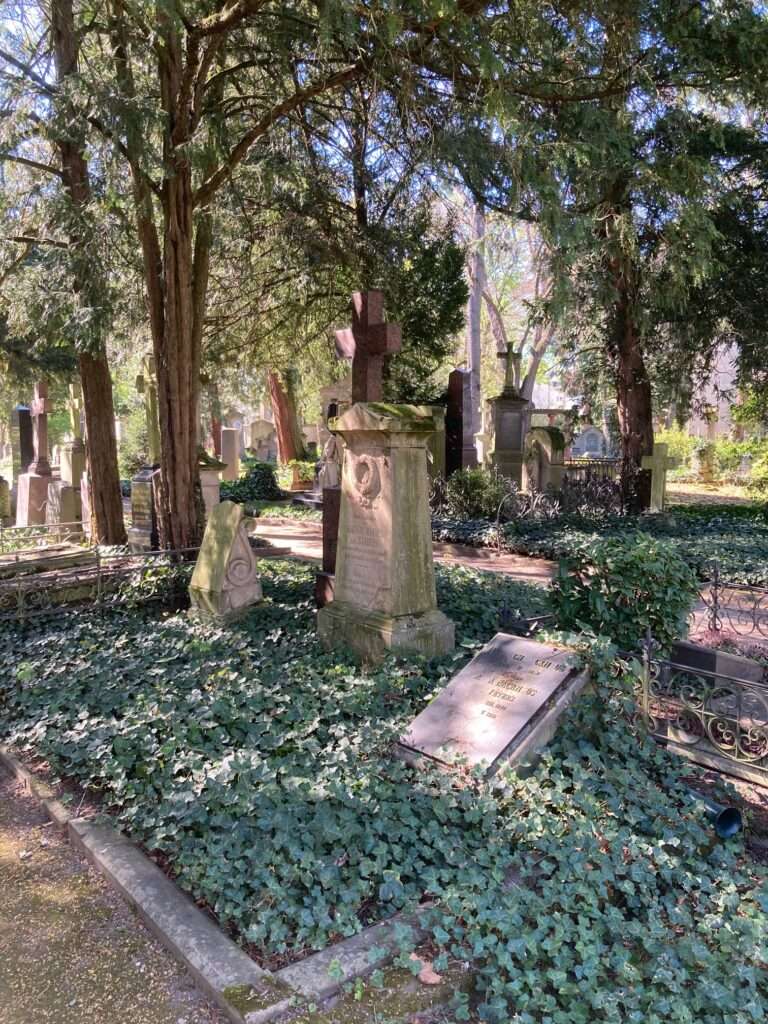
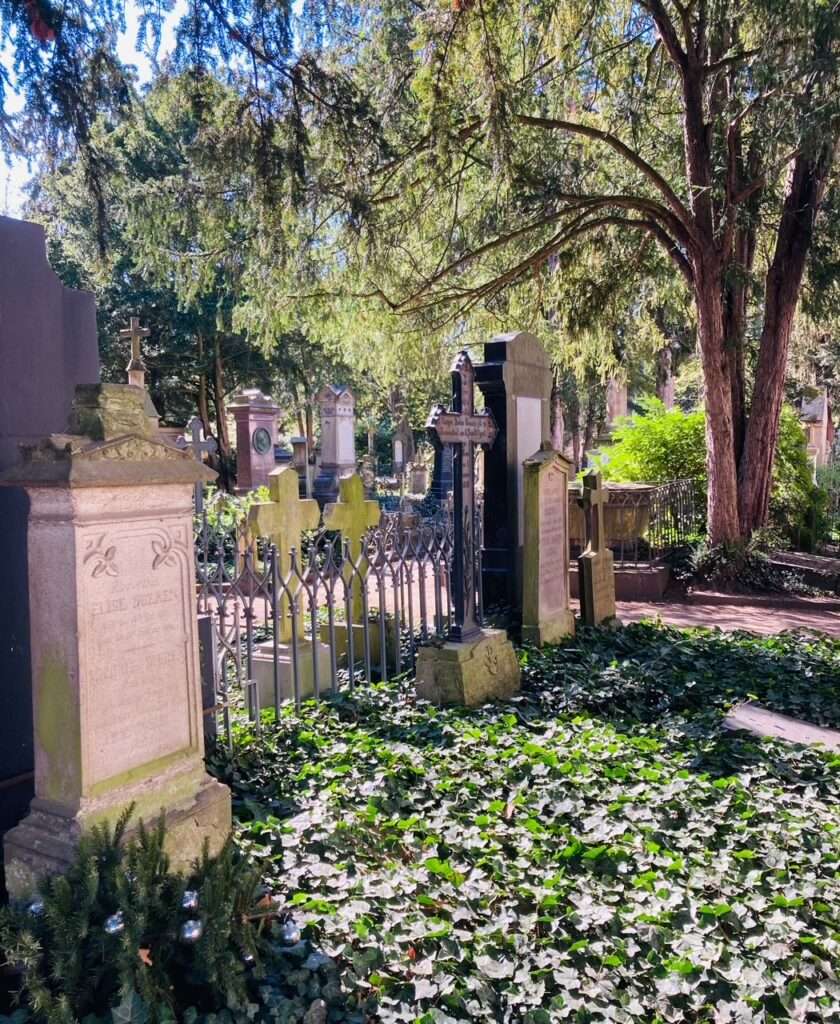
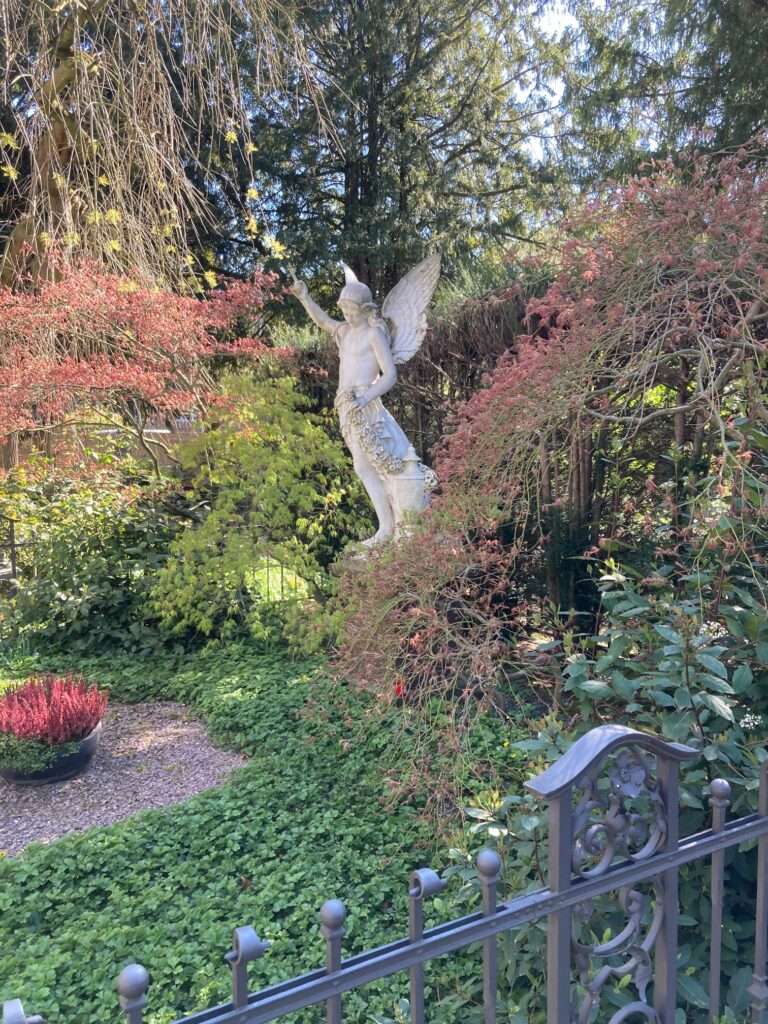
 Another treasure of the Old Cemetery is its trees, some of which date back to the 19th century. This is where problems become apparent: in some places, monument preservation and nature conservation compete with each other, as the tree roots threaten historic graves. Nowhere is this more evident than at the grave of Ernst Moritz Arndt, where the oak tree he planted himself almost 200 years ago is in the process of overturning the gravestones.
Another treasure of the Old Cemetery is its trees, some of which date back to the 19th century. This is where problems become apparent: in some places, monument preservation and nature conservation compete with each other, as the tree roots threaten historic graves. Nowhere is this more evident than at the grave of Ernst Moritz Arndt, where the oak tree he planted himself almost 200 years ago is in the process of overturning the gravestones.
 In the first phase the white-flowered cherries, such as the plum cherry in Wolfstraße, Franzstraße or in the Rheinaue, bloom. After that it takes about 14 days for the thick pink-flowered Japanese flowering cherries (especially in Breite Straße and Heerstraße) to delight the eye.
In the first phase the white-flowered cherries, such as the plum cherry in Wolfstraße, Franzstraße or in the Rheinaue, bloom. After that it takes about 14 days for the thick pink-flowered Japanese flowering cherries (especially in Breite Straße and Heerstraße) to delight the eye.

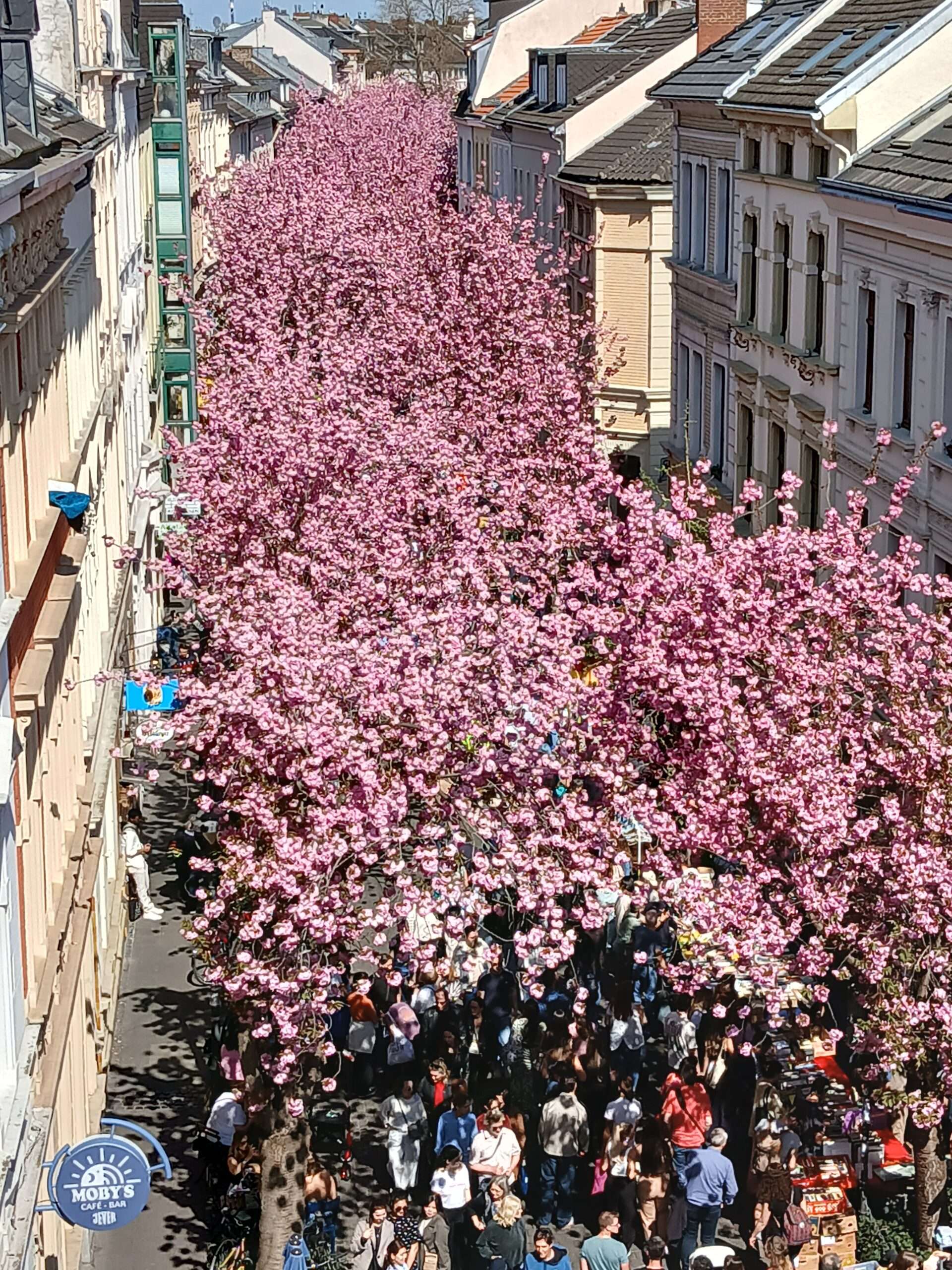

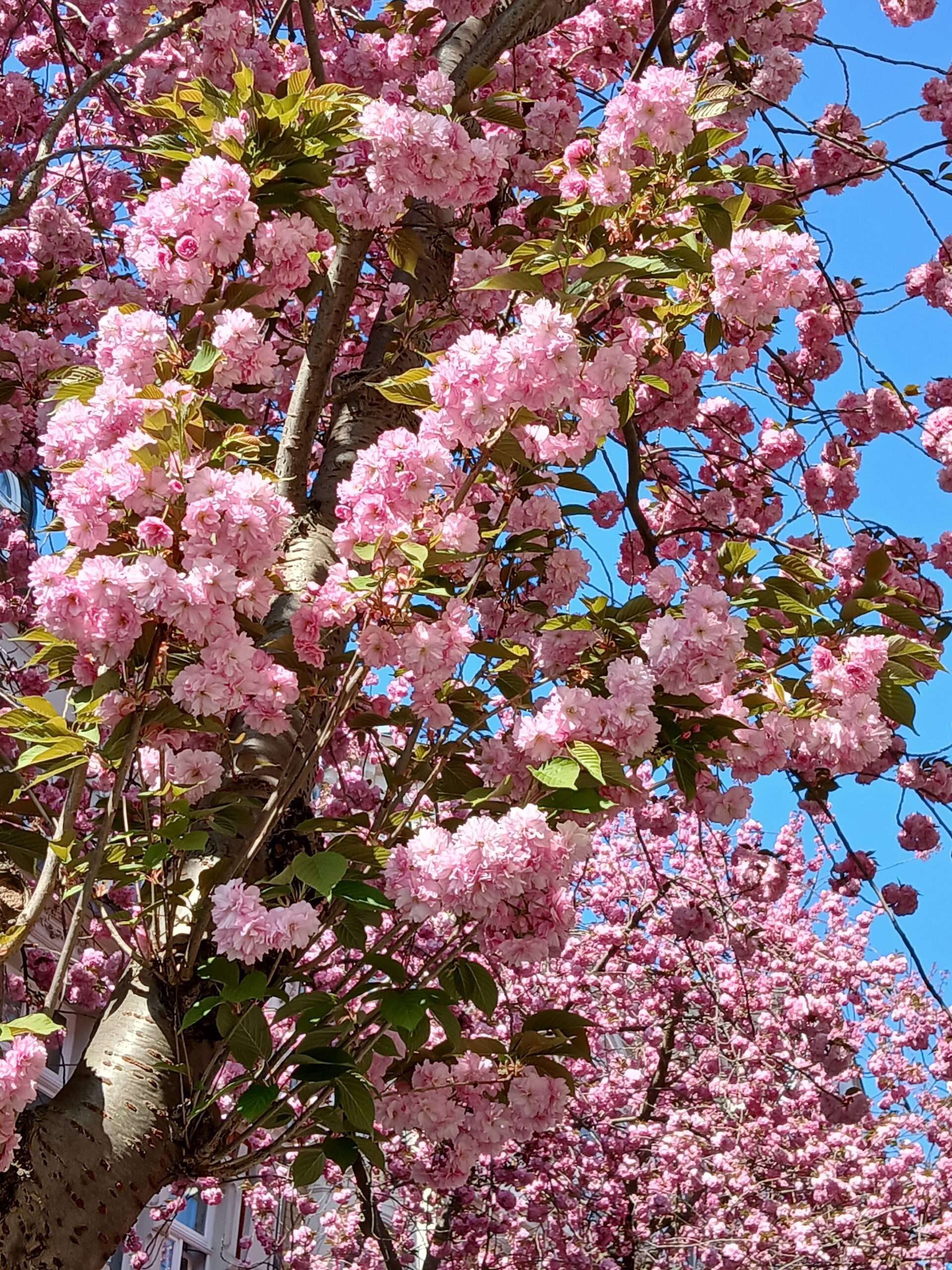
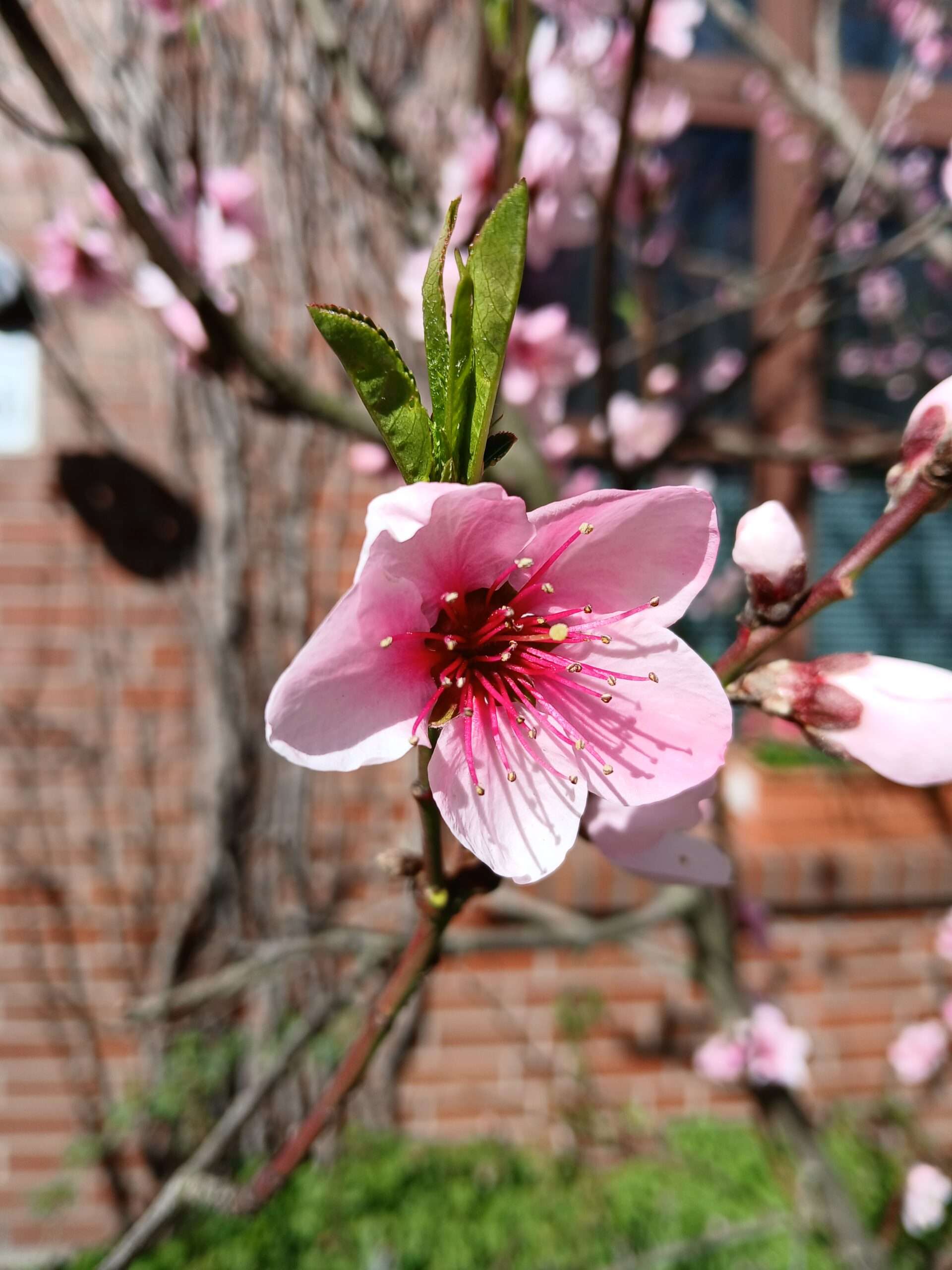

 numerous in Bonn and the surrounding districts. Each carnival club has different ‘uniforms’ or costumes. The uniforms date back to the French occupation at the end of the 18th / beginning of the 19th century. The occupiers banned carnival because they feared unrest. But after the occupation ended people celebrated again, wearing the uniforms the French had left behind. This was a way of making fun of the occupiers, and later also of the Prussian occupiers. One remnant is the ‘
numerous in Bonn and the surrounding districts. Each carnival club has different ‘uniforms’ or costumes. The uniforms date back to the French occupation at the end of the 18th / beginning of the 19th century. The occupiers banned carnival because they feared unrest. But after the occupation ended people celebrated again, wearing the uniforms the French had left behind. This was a way of making fun of the occupiers, and later also of the Prussian occupiers. One remnant is the ‘ day, cut off the ties of the men and symbolically take power. This custom was introduced over 200 years ago, in 1824, by the Beuel washerwomen. At that time, the men brought the freshly washed laundry to Cologne by ship, received payment for it and promptly squandered it during Carnival. In 1824 the washerwomen had had enough and decided to take drastic action. They got together for a coffee klatch and founded the Old Beuel Women’s Committee 1824 e. V. Since then, the town hall has traditionally been stormed in Beuel where the
day, cut off the ties of the men and symbolically take power. This custom was introduced over 200 years ago, in 1824, by the Beuel washerwomen. At that time, the men brought the freshly washed laundry to Cologne by ship, received payment for it and promptly squandered it during Carnival. In 1824 the washerwomen had had enough and decided to take drastic action. They got together for a coffee klatch and founded the Old Beuel Women’s Committee 1824 e. V. Since then, the town hall has traditionally been stormed in Beuel where the  of people on foot and musicians and bands parade through the city centre and the northern part of the city. Thousands of people line the route and collect sweets and bouquets of flowers. For those who have never been: make sure you have enough bags for the sweets.
of people on foot and musicians and bands parade through the city centre and the northern part of the city. Thousands of people line the route and collect sweets and bouquets of flowers. For those who have never been: make sure you have enough bags for the sweets. It is definitely worth taking part in the carnival adventure, even if you are not from Bonn.
It is definitely worth taking part in the carnival adventure, even if you are not from Bonn.



 The steps of Bonn’s old City Hall have seen similar scenes time and again, especially when Bonn was the capital city of Germany. The list of visitors ranged from Theodor Heuss, who addressed the German people from the steps immediately after his election as the first Federal President, to John F. Kennedy in 1963, the Queen Elizabeth of England in 1965, and as late as 1989 when Gorbachev visited. Not all occasions were as spectacular as in the 60s, and over time, state visits became routine. Nevertheless, the steps of the town hall remained something of a stage for the Bonn Republic. The reason for this was mundane: the government district was somewhat remote and, as a provisional arrangement, had no representative assembly area. The market square helped out.
The steps of Bonn’s old City Hall have seen similar scenes time and again, especially when Bonn was the capital city of Germany. The list of visitors ranged from Theodor Heuss, who addressed the German people from the steps immediately after his election as the first Federal President, to John F. Kennedy in 1963, the Queen Elizabeth of England in 1965, and as late as 1989 when Gorbachev visited. Not all occasions were as spectacular as in the 60s, and over time, state visits became routine. Nevertheless, the steps of the town hall remained something of a stage for the Bonn Republic. The reason for this was mundane: the government district was somewhat remote and, as a provisional arrangement, had no representative assembly area. The market square helped out.
Recent Comments